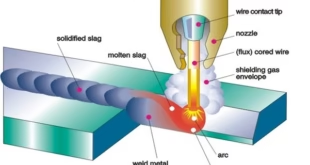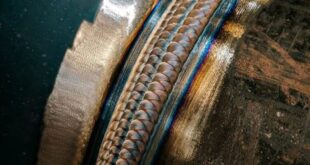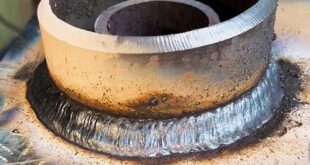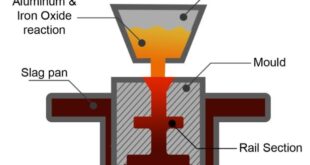Magnetically Impelled Arc Butt (MIAB) Welding
Introduction
Magnetically impelled arc butt (MIAB) welding (also known as rotating arc welding). MIAB is a forged welding process for joining pipes and tubes with an external magnetic field affecting arc rotation along the tube circumference. Forging is a method of shaping metal through hammering, pressing, or rolling. This welding process relies on an electric arc to generate the necessary heating to melt the surfaces being welded.
MIAB welding is an advanced type of welding process that is a replacement for general welding processes such as friction, resistance, and butt welding. It is a type of solid-state welding process used for tubes and pipes in which heat is generated through an electric arc. MIAB has been developed since the 1970s. MIAB welding was developed for welding non-ferrous metals like aluminum and copper as compared to conventional welding processes.
Working Principle
In the MIAB welding process, the two components that are to be welded are clamped in MIAB welding equipment with a small gap between both ends. In the first step, a direct current (DC) arc is kept between the component ends. Then a radial magnetic field causes this arc to travel around the joint circumference at high speed. heating continues and in the second step, heating continues for a few seconds then, in the second stage, the components are joined together at a forging pressure Any molten material is expelled from the joint, and as a result, a solid phase weld is produced. The components remain fixed they do not rotate during the whole welding process. There is a good thing in MIAB, no filler metal or shielding is required, and as a by-product, it only produces a little fume. Example of MIAB welding is low and medium carbon steel and low alloy steel etc. MIAB welding has many applications such as: in the production of drive shafts, propeller shafts, beam axles, axle casings, and refrigerator condenser tubes. MIAB welding process is used in the United Kingdom and Germany for welding tubular sections in automobile industries. Advanced MAIB welding has brought a revolutionary change in the automotive industry nowadays.

MIAB welding is a type of solid-state welding. Its process involves the rotation of the arc around the tube to help the uniform heating of faying surfaces (two mating surfaces that are to be joined). The tubes which are to be welded together are aligned together by clamping arrangement and the external constant magnetic field is applied in the weld area. And heat is generated in the faying edges through electrical discharge and rotation of the arc by application of the external magnetic field. After required heating, the tubes are forged (pressed) to expel the molten metal and other impurities from the faying surface resulting in a solid state joining of tubes. After this, the welded parts are rapidly brought under pressure.
Properties of MIAB welding
MIAB welding process is a simple, cheap, and less time taking process, it is a single-shot process and doesn’t require any manual skill and could be easily performed automatically. Its welding time of 22 seconds for a pipe of thickness 6 mm which is quick and fast. It produces a solid-state bonding after welding which have excellent mechanical properties. It also opens up the possibility of dissimilar metal joints. It has many advantages; it has a less internal flash, shorter weld time, less metal loss, less expensive, low operating current, uniform heating, and less or no machine maintenance. It does not involve rotation of either component (therefore it overcomes problems with asymmetrical parts that occur with friction welding processes).

Relationship Between Parameters in MIAB welding
In MIAB welding, the arc rotation speed is dependent on four main parameters. These four parameters include 1-welding current, 2-Arc voltage, 3-magnetic coil voltage, and 4-magnetic coil current. Where the arc speed varies linearly along with welding current and voltage in a plot. From the experimentation, it is clear that welding current has more impact on arc speed than the remaining three parameters. The performance analysis shows that the welding current controls the arc speed more than the welding input voltage. Whereas, the magnetic coil current and voltage have very less or no impact on the arc speed.
Equipment and Setup:
Overview of the MIAB Welding Machine
The MIAB welding machine is a specialized equipment designed to perform Magnetically Impelled Arc Butt (MIAB) welding. It incorporates various components that facilitate the welding process and ensure the generation of a magnetic field and an electric arc for efficient metal joining.
Components of the MIAB Welding Setup
Power Source and Control Unit: The power source is a crucial part of the MIAB welding setup, providing the electrical energy required to create the welding arc and the magnetic field. The control unit allows operators to adjust welding parameters such as current, voltage, and magnetic force to optimize the welding process for different materials and joint configurations.
Electrodes and Their Selection: MIAB welding utilizes consumable electrodes that act as a filler material during the welding process. These electrodes must be selected based on the specific material being welded and the welding parameters. The proper selection of electrodes ensures adequate fusion and metallurgical compatibility between the base materials.
Magnetic Coil and Its Configuration: The magnetic coil is a fundamental component responsible for generating the magnetic field that impels the arc. It is typically positioned around the joint to create a magnetic pressure on the arc, directing it between the workpiece edges for efficient welding. The configuration of the magnetic coil may vary depending on the joint design and material thickness.
Workpiece Clamping Mechanism: To ensure proper alignment and stability during MIAB welding, a workpiece clamping mechanism is employed. This holds the workpieces firmly in place to prevent any misalignment or movement during the welding process, resulting in precise and consistent welds.
Safety Precautions and Considerations During Setup
MIAB welding, like any welding process, involves potential hazards that must be addressed to ensure operator safety and protect the surrounding environment. Safety precautions during setup may include:
Personal Protective Equipment (PPE): Operators should wear appropriate PPE, including welding helmets, face shields, flame-resistant clothing, gloves, and safety boots to safeguard against arc flash, sparks, and molten metal.
Ventilation: Adequate ventilation in the welding area is essential to prevent the accumulation of fumes and gases generated during the welding process.
Electrical Safety: Proper grounding of the welding equipment and regular inspections of cables and connections are necessary to avoid electric shock hazards.
Fire Prevention: Fire extinguishers should be readily available, and the workspace should be free of flammable materials to prevent potential fires.
Training and Certification: Operators should receive comprehensive training on MIAB welding techniques, equipment operation, and safety practices. Certification ensures that they are qualified to perform the welding process safely and effectively.
Comparison with Traditional Methods
MIAB Welding vs. MIG Welding
- MIAB welding utilizes a magnetic field to impel the arc, while MIG welding relies on a continuously fed consumable wire as the electrode.
- MIAB welding offers better control over the arc and results in reduced heat input, leading to minimized distortion and a smaller heat-affected zone (HAZ).
- MIG welding is generally more accessible and easier to learn for beginners, but MIAB welding provides higher welding speeds and improved efficiency for skilled operators.
MIAB Welding vs. TIG Welding
- TIG welding uses a non-consumable tungsten electrode and a separate filler rod, while MIAB welding uses consumable electrodes.
- TIG welding is suitable for precise and intricate welds, particularly in thin materials, whereas MIAB welding is more suitable for thicker materials and higher welding speeds.
- MIAB welding can produce welds with better penetration and fusion due to the magnetic impelling force, making it advantageous for certain applications.
MIAB Welding vs. SMAW
- SMAW employs a consumable coated electrode that provides both the filler material and the shielding gas, whereas MIAB welding requires a separate magnetic coil for arc impelling.
- MIAB welding usually results in cleaner welds with fewer slag inclusions, as the magnetic force helps to direct the arc more precisely.
- SMAW is known for its versatility, portability, and ability to work in various positions, while MIAB welding offers improved efficiency and reduced operator fatigue for long welds.
MIAB Welding VS Friction Welding, Electron Beam Welding
MIAB Welding vs. Friction Welding
- Friction welding is a solid-state welding process that involves rubbing two workpieces together to generate heat, then forging them together to form a bond.
- MIAB welding is an arc welding process that uses the magnetic force to impel the arc, resulting in fusion of the workpieces.
- Friction welding is well-suited for joining dissimilar materials and can handle irregularly shaped workpieces, whereas MIAB welding offers better control over the welding process and higher weld quality.
MIAB Welding vs. Electron Beam Welding
- Electron beam welding utilizes a high-velocity beam of electrons to generate heat and join materials without the need for a filler material.
- MIAB welding requires consumable electrodes to provide filler material during the welding process.
- Electron beam welding is particularly suited for precision welding of thin materials and has a deep weld penetration capability, whereas MIAB welding is advantageous for thicker materials and higher welding speeds.
Advantages of MIAB Welding
High-quality welds with minimal defects: MIAB welding produces high-quality welds due to the precise control over the welding parameters and the interaction between the magnetic field and the arc. The process ensures better fusion between the base metals, resulting in fewer defects such as porosity, inclusions, and lack of fusion.
Reduced heat-affected zone (HAZ): MIAB welding minimizes the heat-affected zone around the weld joint. The localized heating provided by the magnetic arc results in less distortion and stress on the surrounding material. This is particularly beneficial for materials that are sensitive to heat, as it helps maintain their mechanical properties and reduces the need for post-weld heat treatment.
Improved productivity and efficiency: MIAB welding offers higher welding speeds compared to traditional welding techniques. The rapid localized heating provided by the magnetic arc results in faster weld solidification, leading to increased productivity and shorter production times. This efficiency can result in cost savings and improved manufacturing throughput.
Suitable for a wide range of materials: MIAB welding is versatile and can be applied to various materials, including metals and alloys with different thicknesses and properties. It can be used for welding dissimilar materials, which makes it valuable in industries where joining different materials is common, such as in aerospace and automotive manufacturing.
Limitations and Disadvantages
Initial setup costs: The equipment required for MIAB welding can be expensive, especially when compared to traditional welding methods. The magnetic coil, power source, and control unit contribute to higher initial investment costs. However, the long-term benefits in terms of improved productivity and weld quality may offset these upfront expenses.
Limited joint accessibility in some cases: MIAB welding may have limitations in reaching certain joint configurations or locations due to the need for the magnetic coil to be positioned appropriately. Complex joint geometries or confined spaces might be challenging for the magnetic field to penetrate effectively, limiting its application in certain scenarios.
Operator skill and training requirements: MIAB welding demands skilled operators who are familiar with the process, its setup, and parameter adjustments. The control of the magnetic field and arc interaction requires specialized knowledge and experience. Adequate training and experience are essential to ensure consistent and high-quality welds, which may require additional investments in workforce development.
Applications of MIAB Welding
MIAB welding has many benefits over other welding types. MIAB welding is free of rotation of any component hence there is no chance of fiction issues. It is a quick or less time-taking process. It is a loss-free method, there is low or no material loss involved. It is safer than other methods as it produces low fumes and spatter. MIAB welding requires a relatively low required arc current in the whole process. MIAB welding uses an electric arc for heating near joints instead of other welding processes that use resistance to accomplish heating. MIAB is considered a non-consumable electrode arc welding process, that preserves the welding parts and does not consume them in the process instead it uses electrode arc for this purpose. There are many applications of MIAB welding that are listed below:
- It is used for welding thin-walled tube
- Butt and T-butt welding are used to join automobile parts
- It is used for thick-walled tubes welding
- It is also used for welding solid parts
- It is used for welding tubes in plate welding and flange welding
- It is used in pipe and tube assemblies and shock absorber assemblies
- It is used in Vehicle driveshafts
- It is used in brake pipes
- It has other applications in the power, automobile, defense, oil, and gas sectors
FAQs
What is Magnetically Impelled Arc Butt (MIAB) welding?
MIAB welding is an advanced welding technique that uses magnetic forces to control the arc and improve heat distribution during the welding process, resulting in high-quality joints.
What materials can be welded using MIAB welding?
MIAB welding is versatile and can be used to weld various materials, including ferrous and non-ferrous metals.
What are the advantages of MIAB welding over traditional welding methods?
MIAB welding offers benefits such as minimal distortion, reduced material waste, and the ability to weld thick sections in a single pass, leading to improved efficiency and cost-effectiveness.
Is specialized equipment required for MIAB welding?
Yes, MIAB welding requires specialized equipment designed to generate the necessary magnetic fields and control the arc, making proper training and investment essential for successful implementation.
What are the potential challenges of adopting MIAB welding?
The main challenges include the initial capital investment for acquiring specialized equipment and the need for skilled operators to ensure optimal performance and results.
What are the applications of MIAB welding?
MIAB welding stands for Magnetic Induction Arc Butt welding, is a process used to join two metal parts together by heating them with an electrical arc that is generated by induction. It is typically used to join pipes and tubes made of materials such as stainless steel, aluminum, and copper.
What are the stages of MIAB welding?
The stages of MIAB welding include:
- Preparing the parts to be welded by cleaning, aligning, and clamping them in place
- Applying a magnetic field to the parts to be welded
- Passing an electric current through the parts, which generates an arc that melts the surfaces of the parts
- Applying pressure to the parts to fuse them together as they cool
Conclusion
Magnetically Impelled Arc Butt (MIAB) welding stands out as a highly promising and efficient welding technique that offers several advantages over traditional welding methods. Throughout this article, we have explored the key principles and characteristics of MIAB welding, delving into its unique process and benefits.
 Welding of Welders All about Welding and Welders
Welding of Welders All about Welding and Welders



